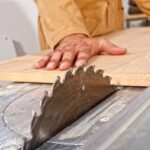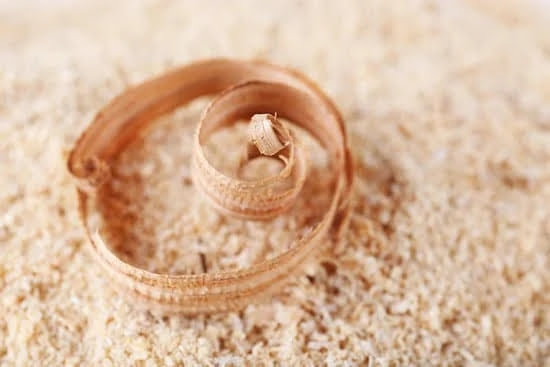Introduction
Crosscut saw blade woodworking is the use of a specialized type of saw to cut across the grain of a wooden piece. This type of saw has wide and thin teeth which makes it most effective for cutting wood in a straight line. Crosscut saw blades also come in many different types and sizes, allowing them to be used for a variety of applications including carpentry, furniture making and cabinet making. In addition, crosscut saw blades offer superior accuracy and they can produce clean, smooth cuts even in tough materials like hardwoods. With proper use and maintenance, they are designed to last for many years without becoming damaged or dulling. When it comes to woodworking, having a quality crosscut saw blade is essential for achieving the desired results.
Using a crosscut saw blade correctly is essential for achieving successful results. Considerations such as feed angle, cutting speed, depth and height adjustments must all be taken into account prior to use. Additionally, it’s important to ensure that the tension on the blade is set properly in order to prevent any damage that may occur from incorrect tensioning. Once all of these details have been taken care of, then you can begin using your crosscut blade with confidence knowing that it will provide clean cuts every time!
Exploring the Different Materials Used for Crosscut Saw Blades
Crosscut saw blades are an important tool for woodworking, and the choice of material used in their construction can make a huge difference in their utility. The two most common materials for the blades of modern crosscut saws are high speed steel (HSS) and tungsten carbide.
High speed steel is an alloy mix of carbon, chromium, tungsten, and vanadium that creates a strong yet resilient metal capable of withstanding extreme temperatures which makes it ideal for crafting tools like saw blades. HSS is well-suited for making cuts in wooden objects as it produces a smooth finish and is less prone to dulling or warping than other metals. This combination of strength, durability, and cutting accuracy explains why many people prefer it over other choices when selecting a crosscut saw blade.
The alternative type of material used to construct crosscut saw blades is tungsten carbide. Besides being incredibly hard and durable due to its unique blend of metal compounds and binding agents, tungsten carbide blades typically feature teeth that are arranged into special patterns designed to reduce friction between the blade and the workpiece while cutting. Furthermore, its ability to resist vibration makes it ideal for creating precise cuts without kickback or excessive wear on the blade’s teeth. For these reasons, many professional woodworkers choose tungsten carbide blades when crafting precision pieces like cabinets or furniture from hardwoods such as oak or walnut.
In addition to these two popular types of materials employed in crosscut saw blade manufacturing, there are other options available as well such as cermet (ceramic + metal) alloys which offer slightly different qualities than either HSS or tungsten carbide. Whether one chooses HSS, tungstic Carbide or another option like cermet will ultimately come down to how much he/she values qualities such a sharpness, longevity or total cost depending on the specific project requirements.
The History of Crosscut Saws
The use of crosscut saws dates back to ancient times. Across the world, many cultures employed similar tools used for cutting across the grain of trees and other timber – from wooden designs used by Mesopotamians in the Middle East to American Indian stone saw blades. In Europe, early resource-based economies saw a dramatic surge in timber usage by the 1600s when commercial logging began appearing in France and Germany. Even though great advances were being made regarding iron casting throughout much of Europe, professionals needed reliable, efficient tools for precision cutting of logs into planks; hence, crosscut saws became standard issue tools among craftsmen leading up to the 1800s.
As forging methods improved over time so did crosscut saw production techniques which eventually led to mechanized saw blade factories springing up around the world. This resulted in larger teeth that remained sharp longer, as well as improved handle design that reduced fatigue and strain on woodworkers’ bodies. By the late 19th century, crosscut saw blades had been successfully tailored for various woodworking applications such as paneling, trimming and edging along with standard window finishing techniques – all requiring different types of cutting styles depending on what particular job was at hand. The history of modern woodworking is forever tied to these invaluable tools: they continue to be favored by skilled tradesman near and far as production methods have evolved over time.
Different Types of Crosscut Saw Blades
A crosscut saw blade is an essential tool for woodworking projects and a wide variety of saw blades are available. Carbide-tipped saw blades are the most common type, featuring a thin blade with teeth made from tungsten carbide. They provide accurate straight cuts on both hardwoods and softwoods. These blades can be used to create joinery, such as half laps, lap joints or dovetails. Rip saw blades are wider than crosscut blades and they have taller teeth with a more aggressive cutting angle. They produce clean cuts parallel to the grain and can be used for ripping wooden boards into narrower pieces or cutting thick pieces of stock quickly. Combo saw blades feature alternating teeth, allowing them to make both rip and crosscut cuts efficiently in one pass. MTJ (magnum tipped metal) blades incorporate three types of tooth geometry which provide fast cuts without leaving splinters. Finally, titanium nitride coating on many modern saw blades reduce gumming up and increases their cutting performance extending the life of the blade significantly.
Benefits of Working with Crosscut Saw Blades
Crosscut saw blades are a great way for woodworkers to quickly and accurately make cuts. The blades have a specially designed teeth configuration which is shaped like an “X” and allows the blade to cut through most types of woods with ease and precision. Crosscut saw blades are especially beneficial because they minimize chipping and splintering, allowing for more precise cuts and better overall finish. Another benefit of working with crosscut saw blades is their ability to provide quicker cutting times than other saw blades. The sharper angle of the teeth angle in combination with the relatively small size of the blade makes it great for fast cutting jobs or in tight spaces where larger saws may not fit comfortably or easily. Finally, crosscut saw blades offer versatility in that they can be used to make both straight angles as well as bevel cuts with ease—perfect for creating moldings or trim work on projects that require added detail or custom pieces.
Selecting the Right Crosscut Saw Blade for the Job
The key to success when making crosscuts with a saw blade is to select the right saw blade! This can make all the difference in achieving an accurate cut, or creating a mess. Before selecting a blade, you must consider the type of material you will be working with and ask yourself if the tool requirements are strong enough.
A high-quality saw blade should have a minimum number of teeth to ensure an even and smooth cut. If a woodworker is cutting softwood that has no grain, then fewer teeth on the blade would be more suitable. On the other hand, if a woodworker needs to make crosscuts on hardwoods with strong grain patterns, then they may want to invest in a saw blade with more teeth. For example, using 24 teeth on hardwood and 12-15 teeth for softwood will create cleaner cuts without splintering or burning up the workpiece.
Additionally, it’s important to pay attention to tooth size and spacing. Most standard blades require 3/8 inch set between each tooth; however, different sized cuts need different tooth spacings or kerf widths (the thickness of the portion being removed). Choosing a blade with wider or smaller spacing helps manage chip out caused by grain reversal – when one side of the grain behaves differently than another. By changing these settings accordingly for different pieces of wood, woodworkers can better control their finished edges and ensure clean cuts throughout their project. Finally, some blades come specially designed for specific uses such as ripping downward in grains versus sideways along them; be sure to select a blade that best suits your project goals!
The Process of Using Crosscut Saw Blades for Woodworking
Crosscut saw blades are a type of blade specifically designed to cut wood in a crosswise manner and is used by carpenters and woodworkers in a variety of applications. To use a crosscut saw blade, the end user generally uses special tools to secure the blade against the surface of the material before using a hand saw or power tools to cut it. As with all blades, caution should be exercised when working with these tools since their edges are very sharp.
Once the user has secured the blade firmly against the material, they can then use either a manual or electric saw to begin cutting. For manual cuts, users should make sure that they have both hands on their saw as they run it across the material’s surface. Important safety measures may also include wearing protective clothing such as goggles, gloves and other forms of eye protection to ensure maximum protection.
Crosscut saws can make precise and repeatable cuts which makes them an incredibly valuable tool for any type of woodworking project. Additionally, they provide excellent versatility as they can be used to make straight cuts or multiple angled cuts depending on what is needed for specific projects. In addition to cutting wood, some crosscut saws can also be used to cut through metals like aluminum, brass and steel which makes them exceptionally versatile pieces of equipment.
How to Maintain a Crosscut Saw Blade
Maintaining a crosscut saw blade is essential if you want to get the best performance and longevity out of your saw. Here are some tips to keep it in top condition:
1. Cleaning – Always make sure to clean your saw blade regularly and thoroughly by removing any accumulated dirt and dust with a soft cloth or brush.
2. Storage – When you’re not using it, store the blade away from direct sunlight and excessive humidity, preferably in a carry case or box rather than just lying around unprotected. This will reduce wear and tear on the blade and help prevent rusting.
3. Sharpening – It’s particularly important to sharpen your crosscut saw blade regularly, as this can make a huge difference in terms of both performance and the lifespan of the tool. The best way to do this is by grinding with a whetstone to ensure an even edge all around.
4. Lubrication – To maximise performance, use oil weekly while sawing to lubricate the blade and help reduce friction. It should never be used when sharpening though, as this may damage the edge of the saw.
5. Other Factors – Avoid using nails or hard objects that could chip or damage the teeth of your crosscut saw blade, as this can have serious consequences for its performance over time (which could end up being costly).
Safety Tips for Working with Crosscut Saw Blades
1. Always use personal protective equipment (PPE) when working with a crosscut saw blade. This should include safety glasses, gloves, ear protection, and a respiratory mask if necessary.
2. Make sure the blade is properly sharpened before each use to avoid it becoming jammed or stalled while cutting.
3. Securely mount the saw blade in the table so that it won’t move during operation.
4. Do not make freehand cuts—always use a miter box or similar guide for accuracy and safety.
5. Don’t force the saw blade through wood; this will only damage the teeth of the blade and cause it to dull faster than normal.
6. When not in use, always unplug the saw from its power source and store it away from children’s reach in a tool chest or other secure location where it will remain safe from moisture and rusting.
7. Ensure that all loose clothing and long hair are kept away from moving parts or blades to reduce risk of injury or entanglement when working with crosscut saw blades.
8. Be aware of your surroundings at all times—keep an eye out for other people in the area who might be at risk of coming into contact with your saw while you’re working with it.
9. Check that there are no obstructions on either side of the blades before starting up the machine in case they get caught as they rotate while cutting wood pieces—this could cause rapid slowing down and re-binding of both blades which can produce kickback forces potentially resulting in injury to operator or bystanders
10 Finally, have someone nearby who can assist you should an emergency occur with general assistance & first aid immediately available where possible
Conclusion
The crosscut saw blade is an essential tool for any woodworker. It is important to select the right blade for your project in order to achieve the desired results. Different blades are designed to cut different types of materials and can be classified as rip, combination, or crosscuts depending on the type of cut they make. If you are just beginning, a general purpose crosscut saw blade can be used for most work involving softwoods and hardwoods. For those with more experience, specialized rip and combination blades offer more precise cutting capabilities. Ultimately, it is important to consider all of your options carefully in order to ensure that you select the optimum saw blade for your woodworking needs.

Hi everyone! I’m a woodworker and blogger, and this is my woodworking blog. In my blog, I share tips and tricks for woodworkers of all skill levels, as well as project ideas that you can try yourself.





